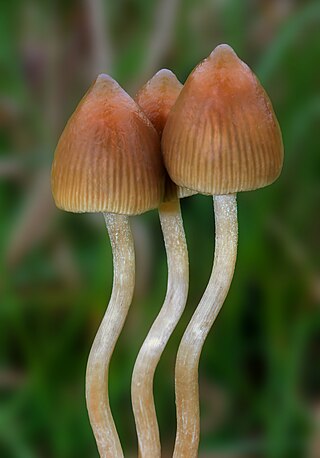
Psilocybe semilanceata, commonly known as the liberty cap, is a species of fungus which produces the psychoactive compounds psilocybin, psilocin and baeocystin. It is both one of the most widely distributed psilocybin mushrooms in nature, and one of the most potent. The mushrooms have a distinctive conical to bell-shaped cap, up to 2.5 cm (1 in) in diameter, with a small nipple-like protrusion on the top. They are yellow to brown, covered with radial grooves when moist, and fade to a lighter color as they mature. Their stipes tend to be slender and long, and the same color or slightly lighter than the cap. The gill attachment to the stipe is adnexed, and they are initially cream-colored before tinting purple to black as the spores mature. The spores are dark purplish-brown in mass, ellipsoid in shape, and measure 10.5–15 by 6.5–8.5 micrometres.

Panaeolus cinctulus, syn. Panaeolus subbalteatus, commonly known as the banded mottlegill, weed Panaeolus, belted panaeolus, or subbs is a very common, widely distributed psilocybin mushroom. According to American naturalist and mycologist David Arora, Panaeolus cinctulus is the most common psilocybin mushroom in California.

Panaeolus is a genus of small, black-spored, saprotrophic agarics. The word Panaeolus is Greek for "all variegated", alluding to the spotted gills of the mushrooms produced.

Panaeolus tropicalis is a species of psilocybin producing mushroom in the family Bolbitiaceae. It is also known as Copelandia tropicalis.

Panaeolina is a small genus of small mushrooms, containing only about four species. They are a subgroup of Panaeolus which have dark brown spores. The type species is Panaeolina foenisecii, a common lawn mushroom. Members of Panaeolina are broadly distributed throughout the world.

Panaeolus cyanescens, commonly known as the blue staining panaeolus, is a mushroom in the Bolbitiaceae family. Panaeolus cyanescens is a common psychoactive mushroom and is similar to Panaeolus tropicalis.
Panaeolus africanus is a little brown mushroom that contains irregular amounts of the hallucinogens psilocybin and psilocin. It has been found in central Africa and southern Sudan.
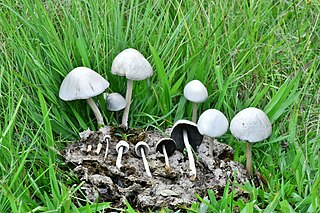
Panaeolus antillarum is a species of mushroom in the family Bolbitiaceae. It is edible but not commonly eaten. It is found from northern North America through Mexico into northern South America.

Panaeolus bisporus, also known as Copelandia bisporus is a rare and widely distributed little brown mushroom that bruises blue and contains the hallucinogen psilocybin.

Panaeolus cambodginiensis is a potent hallucinogenic mushroom that contains psilocybin and psilocin. It was described in 1979 as Copelandia cambodginiensis.

Panaeolus olivaceus is a widely distributed, seldom identified, little brown mushroom that contains the hallucinogen psilocybin; it is often mistaken for Panaeolus foenisecii and is distinguished by its black spore print and darker gill coloration when mature alongside a slightly thicker stem. It is even more easily mistaken for Panaeolus cinctulus or Panaeolus fimicola and can be distinguished from them both by its slightly roughened spores. It is also easily confused with Panaeolina castaneifolia, a species which has spores that are dark brown and significantly more roughened.
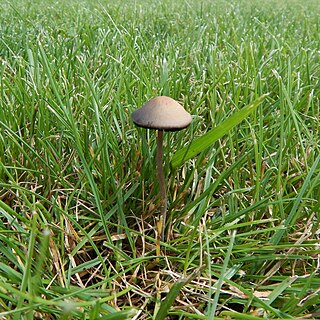
Panaeolus fimicola is a widespread but seldom identified "little brown mushroom" which sometimes contains small amounts of the hallucinogen psilocybin. Panaeolis ater is a synonym. The species is also referred to as the "turf mottlegill".

Panaeolus foenisecii, commonly called the mower's mushroom, haymaker, haymaker's panaeolus, or brown hay mushroom, is a very common and widely distributed little brown mushroom often found on lawns and is not an edible mushroom. In 1963 Tyler and Smith found that this mushroom contains serotonin, 5-HTP and 5-hydroxyindoleacetic acid. In many field guides it is listed as psychoactive; however, the mushroom does not produce any hallucinogenic effects.

Panaeolus papilionaceus, also known as Agaricus calosus, Panaeolus campanulatus, Panaeolus retirugis, and Panaeolus sphinctrinus, and commonly known as Petticoat mottlegill, is a very common and widely distributed little brown mushroom that feeds on dung.

Panaeolus semiovatus var. semiovatus, also known as Panaeolus semiovatus and Anellaria separata, and commonly known as the shiny mottlegill, ringed panaeolus, or egghead mottlegill, is a medium-sized buff-colored mushroom that grows on horse dung, and has black spores. Though nonpoisonous, it is generally regarded as inedible, and a few people experience gastric upset after consumption.
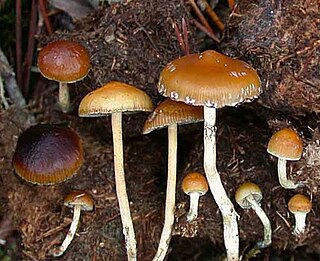
Psilocybe fimetaria is a psilocybin mushroom, having psilocybin and psilocin as main active compounds. It grows exclusively on horse and cow dung.

Panaeolina castaneifolia is a rare and widely distributed little brown mushroom.
Panaeolus microsporus is a species of mushroom in the Bolbitiaceae family. It is a psychoactive species of the Panaeolus genus, containing alkaloids like psilocybin and psilosin. All Panaeolus species produce serotonin and serotonin derivatives.

Tulosesus impatiens is a species of fungus in the family Psathyrellaceae. First described in 1821, it has been classified variously in the genera Psathyrella, Pseudocoprinus, Coprinarius, and Coprinus, before molecular phylogenetics reaffirmed it as a Coprinellus species in 2001. The fungus is found in North America and Europe, where the mushrooms grow on the ground in deciduous forests. The fruit bodies have buff caps that are up to 4 cm (1.6 in) in diameter, held by slender whitish stems that can be up to 10 cm (3.9 in) tall. Several other Coprinopsis species that resemble C. impatiens may be distinguished by differences in appearance, habit, or spore morphology.
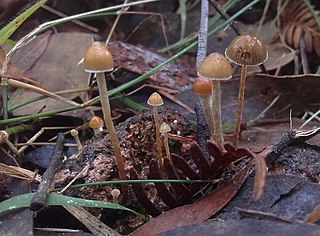
Psilocybe alutacea is a species of agaric fungus in the family Hymenogastraceae. It was described in 2006 and is known from Australia and New Zealand. It is coprophilous, growing on animal dung. The fruitbodies have a small conical or convex cap, subdistant gills with an adnate attachment, a slender brown stipe and a faint blueing reaction to damage. As a blueing member of the genus Psilocybe it contains the psychoactive compounds psilocin and psilocybin.

















